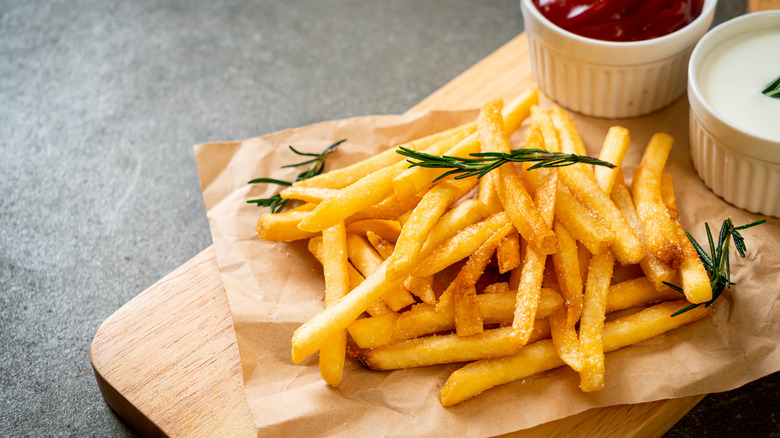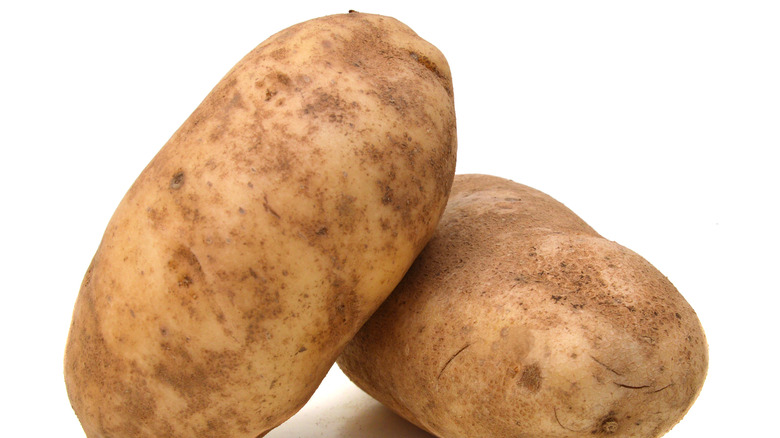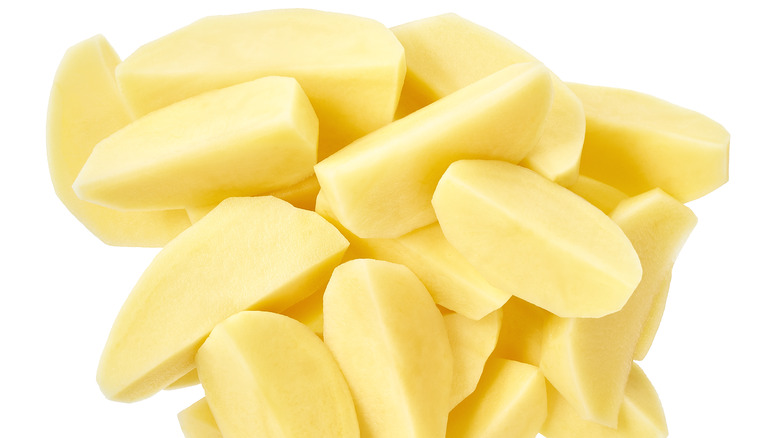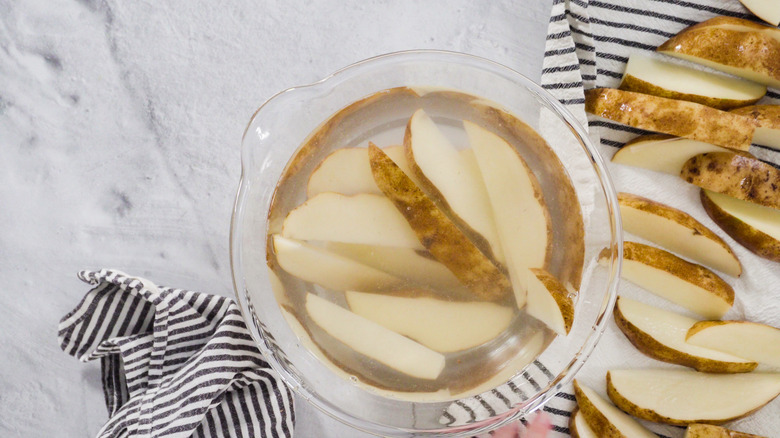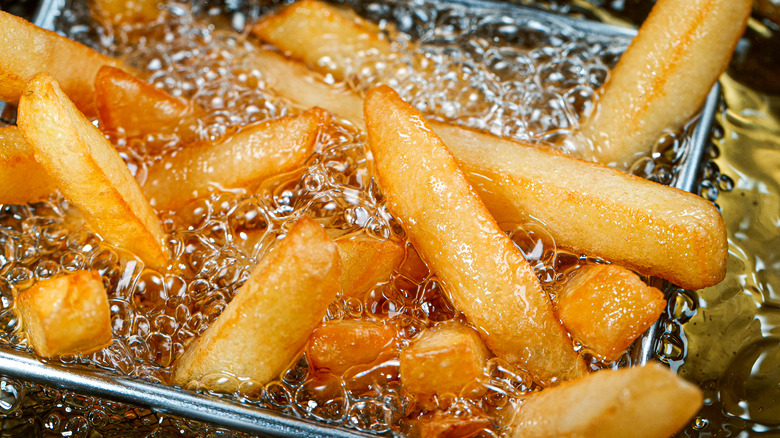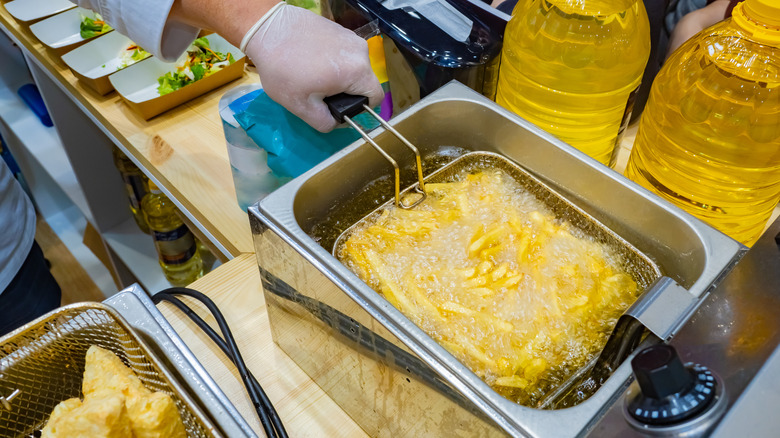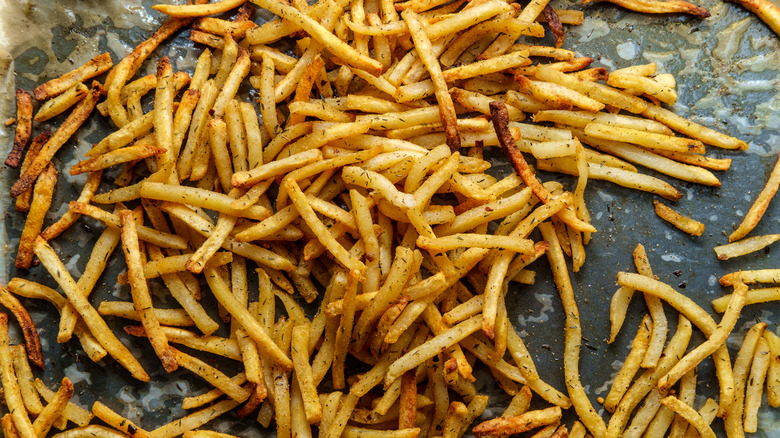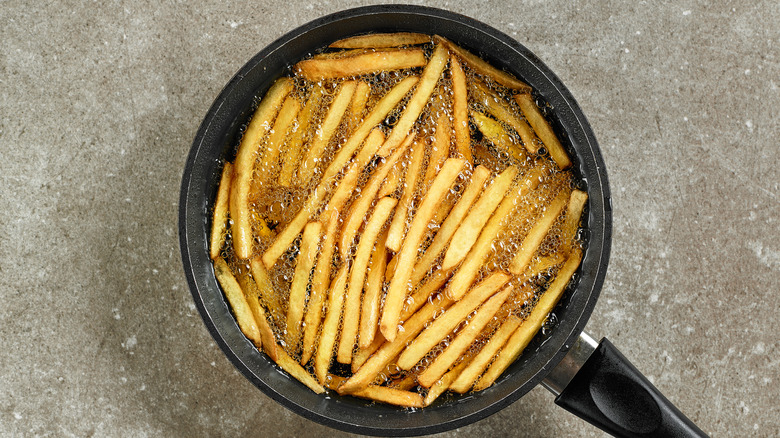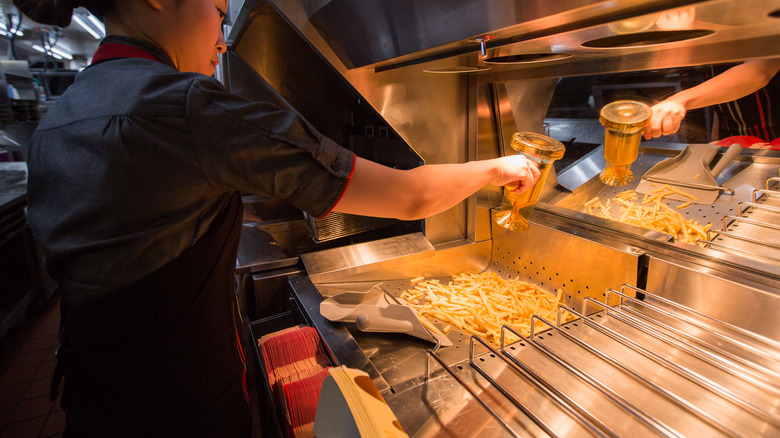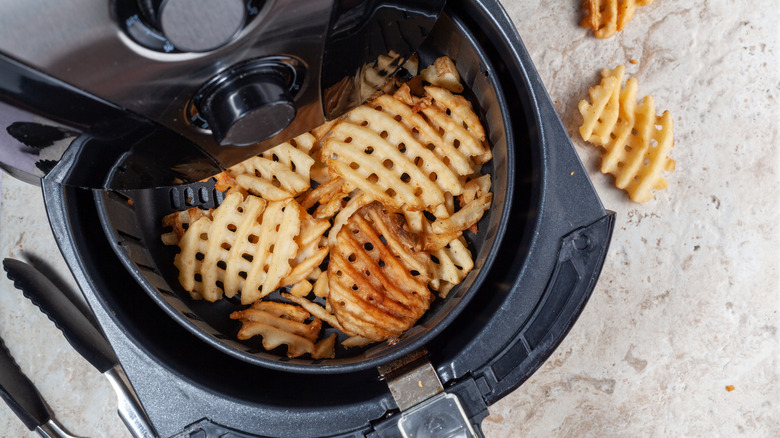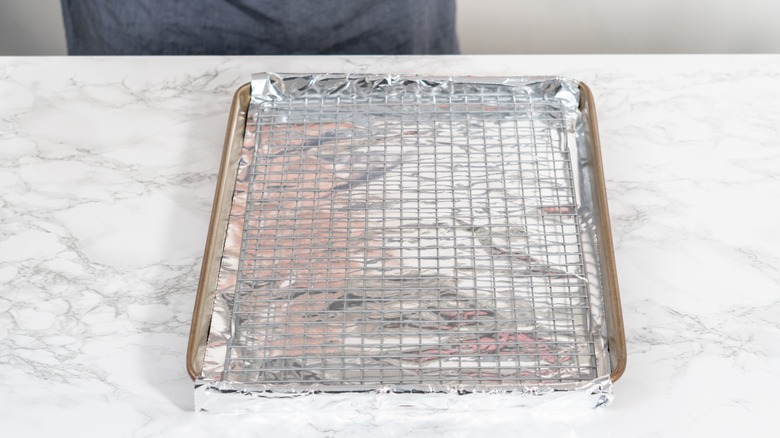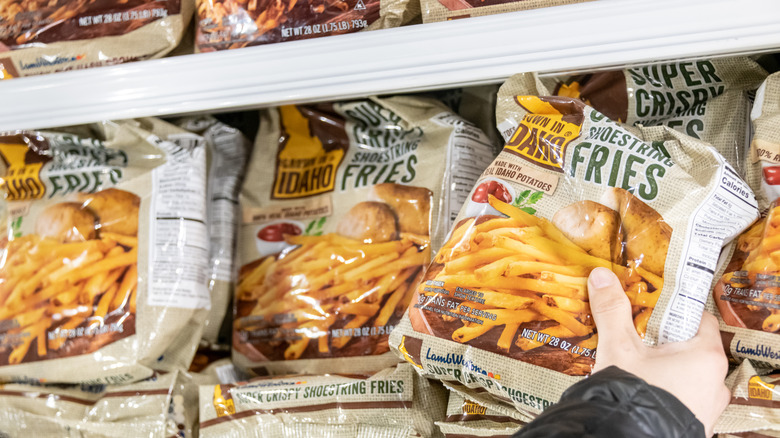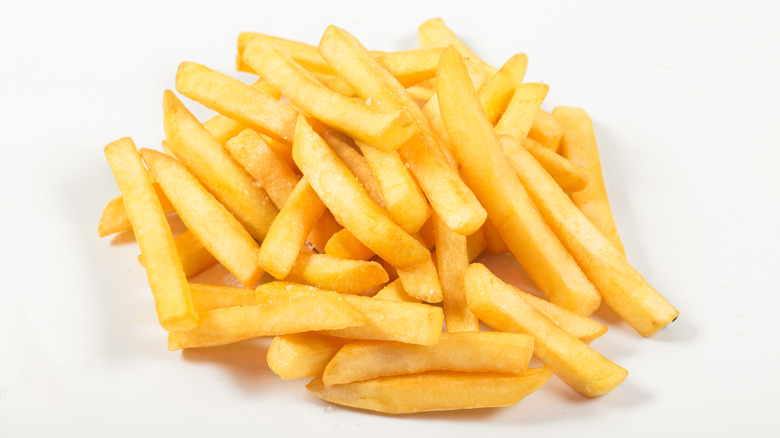12 Mistakes Everyone Makes When Making Fries
Shoestring, steak, crinkled, curly, waffle — no matter the cut, fries are a tasty, popular side dish that goes with everything from fried fish and grilled cheese to shaved truffles and edible gold. You could swing by your favorite fast food place to get some fries or pick up a bag from the freezer section at your local grocery store. But eating out that much can be painful to your budget, and while frozen fries are easy to cook, sometimes you want to make fresh ones instead. So, remembering what you've seen as you watched people at work in fast food restaurant kitchens, you slice up some potatoes and drop them in hot oil. And then you wonder what on earth happened because the fries don't end up tasting like fast food.
Turns out that people make a lot of mistakes when trying to re-create those "crispy on the outside, fluffy on the inside" morsels. This can be chalked up mostly to the myths people believe about french fries and partly to the fact that making good french fries at home is a skill you have to learn. Rather than continue to guess at what you've been doing right or wrong, learn from these mistakes everyone makes when making fries.
Using the wrong variety of potatoes
Technically, you could use any potato to create fries but they wouldn't always be very good fries. If you want really tasty fries, you need to pay attention to the type of potatoes you use. The russet potato is the gold standard because of its starchy center. MasterClass says that cooking forces the cells in the russet to separate, which is what provides the texture when you bite down on a fry. Russets are very dry, too, meaning there isn't much moisture inside the potato that can interfere with the frying process and drag it out. Moisture is either released as steam or absorbed into the surface of the potato piece, and too much moisture means you have to fry the potato for too long a time to get all that moisture out (via Fine Cooking). By the time you're done, the fry is too far gone to be worth eating.
Russets come in a couple of varieties, namely the Russet Burbank and Russet Norkotah (via the Idaho Potato Commission). You may have heard of the Kennebec potato as the potato of choice for In-N-Out, but the Idaho Potato Commission says they're not grown much anymore. Other varieties that work well for fries are the Bintje and Yukon Gem, notes the Idaho Potato Commission, as well as the Yukon Gold and Goldrush varieties, per MasterClass. And note that "Idaho" potatoes are simply russets grown in Idaho.
Cutting potatoes into uneven sizes
How many recipes have you seen where the instructions say to cut ingredients into pieces that are the same size? That's because you want the pieces to cook evenly, according to Michigan State University. One of the biggest mistakes people make when preparing fries is cutting the potatoes into uneven strips or chunks. When you cook pieces of food — be it in oil, boiling water, or even the heat of a dry oven — the heat will work on all of the pieces at the same time. The smaller the piece, the faster it will cook. If you leave that small piece alone while the bigger pieces cook, then that smaller piece will overcook and either burn or fall apart.
Whatever cut you decide to make, you want the pieces to be even. It also helps if they're on the smaller side, according to Good Housekeeping, because frying cooks food very quickly, and the outer portions of a large chunk of food will cook much more quickly than the interior of the chunk, resulting in either undercooked or overcooked food.
Not soaking or rinsing the potato pieces first
Soaking or rinsing the raw, cut potato pieces before cooking is recommended to remove extra starch. Fine Cooking says the starch on the surface of each piece can block the sugars in the potato from reacting with the oil and creating the brownish color that you want your finished fries to have. The U.S. Food and Drug Administration recommends soaking potato pieces in water for 15 to 30 minutes as that appears to reduce the amount of acrylamide, a potential carcinogen. Once the soaking and rinsing are over, you need to dry each potato piece completely. If you don't, you end up with extra moisture that interferes with the frying process, and that extra moisture on the surface of the food can cause hot oil to splatter.
You're going to find a couple of different camps regarding what to soak the potato pieces in. One recommends using salted water; the other says to use plain water. Boss the Kitchen recommends salted water because the salt may help draw out more moisture from the potato pieces. However, the Idaho Potato Commission says the added salt can ruin the frying oil rather quickly, and as the oil is relatively expensive, you're better off conserving the oil you use.
Not blanching the potatoes first
Here's where making fresh fries at home can get complicated. Really good fries are cooked twice, with the first cooking being more of a blanching rather than a drawn-out full frying session. The processes are straightforward, but there are enough variations on what you can do to cook fresh fries that, at first, you might feel overwhelmed. Here are your options. Blanch for a few minutes (depending on shape) in hot oil that is slightly cooler than the oil you use for your second fry (via Idaho Potato Commission). You can parboil the fries in water that has salt, lemon juice, and baking soda in it (via Washington Post). Or give the raw fries a hot-water bath spiked with vinegar, which will cook them slightly, followed by a very fast dip in very hot oil — remember to dry the potato pieces first — followed by the second frying session (via Serious Eats). By the way, there's a cooling step in the middle. More on that later.
If you're cooking frozen fries that you bought at the supermarket, you don't need to blanch them because they are already cooked. In fact, Cook's Country reports that the fries you get from the frozen-food section are already cooked twice, usually by blanching in hot water and then frying. The extra cooking you do is mainly to heat them up and crisp them up.
Frying in the wrong oil
One other very common mistake is to grab whatever cooking oil is available and dunk a bunch of potato pieces in it. The oil you use is a critical link in the chain of cooking fries. The wrong oil can result in everything from bad-tasting food to a terrible-smelling kitchen, not to mention an increased amount of free radicals, according to Serious Eats. When you make fries, you want a neutral-tasting oil that won't overpower the taste of the potatoes, and you want an oil that has a high smoke point so that you don't end up with terrible fries and a smoky kitchen.
Peanut, soybean, and canola oil all have high smoke points and neutral tastes. Healthline warns that peanut oil has enough polyunsaturated fats that the high heat of deep-frying could result in oxidation, which would create free radicals. Too many free radicals could raise your cancer risk (via Seattle Times). Healthline suggests olive oil and avocado oil as possible choices but admits that they aren't neutral-tasting. Coconut oil and palm oil, if you can find a brand that's sustainable, may be worth a try.
Trying to fry all the pieces at once
We know you want your fries to be done as quickly as possible so you can indulge in potato-ey goodness, but jamming all the fries into the oil at once is not going to help you. Unfortunately, that's something that a lot of people do. It may look like that pool of oil can hold a lot of fries, especially if you've seen videos of fry baskets being lifted out of deep-fryers in restaurant kitchens making them really crispy, but the pan you're using at home, no matter how high the sides are, just isn't the same. You've got to fry in batches, giving each piece of potato some space so that oil can surround it.
Overcrowding the frying pan or basket makes it more likely that some pieces will end up undercooked, according to Hamilton Beach. Culinary scientist Jessica Gavin writes that the difference in temperature between the food and the frying oil can affect the frying process. The food, which will be colder than the oil even if the food feels hot, can lower the temperature of the oil. That leads to a soggy batch of fries where the moisture hasn't totally evaporated or been absorbed.
Using a pan that's too shallow for frying
You may think that a frying pan would be the best pan to choose for making fries, but it's not. This is another mistake that people make, and it can lead to a messy outcome. Shallow-sided pans allow oil to pop and splatter outside the pan, which not only makes a mess but also presents a danger to you. That oil is hot. You want a pot with high sides when you deep-fry anything, including fries. Keep a lid nearby in case you need to put out a grease fire.
When you find your perfect pot for frying, don't fill it more than halfway full with oil, according to Good Housekeeping. As the oil heats up and the food in that oil creates bubbles, the oil will rise. You want at least 4 inches of extra space above the surface of the oil to account for this expansion. Without that extra room, you risk oil spattering and spilling out over the rim of the pot.
Adding salt too early or too late
Are you determined to give your fries the best salty flavor you can? Then be very careful when you add salt. A mistake people tend to make is adding salt at the wrong time, either as part of the initial cold soaking or at the wrong point after the frying is done. You already know not to salt the soaking water. As the Idaho Potato Commission says, that extra salt can make oil breakdown faster — and it makes the oil taste salty as well, which transfers to the additional batches of potato pieces that you need to fry. Rather than giving the fries a nice, salty taste, the salty oil just makes everything seem much too salty.
Adding salt after frying can actually be a bit dangerous. Food Above Gold says that if you add the salt right after you take the fries out of the oil, the salt can cause popping and splattering. Instead, take the fries out and place them on something that will absorb the extra oil first, and then add salt when the fries have dried off a bit, but while they're still hot. Don't make the food frying mistake of waiting until the fries cool down because the salt will not stay on the potato. At that point, you're pretty much salting the dish holding the fries instead.
Using cooking spray before air-frying the potatoes
Deep-frying isn't the only way to make fries. The air fryer is a terrific appliance to use for making crispy fries that aren't swimming in grease, but you'll need to be very careful about how far you go in reducing the amount of oil — specifically, avoid cooking spray. Using cooking spray — stuff like Pam — is a fast way to grease a baking dish or cookie sheet, and the speed with which you can do this means you can reduce the amount of fat you're adding to a recipe. That's great if you're trying to cut calories, but cooking sprays react badly with air fryers.
One problem, according to KitchenSnitches, is that the additives in cooking sprays can make the nonstick coating in an air fryer basket peel off. That peeling might not happen the first time you use cooking spray in an air fryer, but microscopic damage to the coating can still occur. Over time, that damage leads to the coating coming off. The last thing you want when you remove that fryer basket is to find those flakes now coating your food. Instead, you can spray regular oil in the basket with an oil sprayer, which is literally a spray bottle made for cooking oil. You can get empty bottles that you fill or buy pre-filled bottles with specific types of cooking oil in them.
Placing a disorganized pile of fries directly on a baking sheet
What if you've decided to forgo deep-frying and don't have an air fryer? There's always the oven, right? But then, if you're like a lot of other people, you end up with two mistakes for the price of one. The first is dumping a pile of frozen french fries on a baking sheet and not organizing them into a single layer. Place the pieces in one layer, nothing overlapping, and add a little space between them if you can.
The second mistake is placing the pieces directly on a baking sheet. Even with a good layer of oil, this setup will leave you with soggy, steamed fries instead of the crispy, golden fries you'd longed for. According to Epicurious, as the potatoes cook in the oven, the moisture on the side against the baking sheet's surface will not be able to drip off the potato piece. Instead, you end up with each piece in its own little pool of moisture, which then evaporates and steams the food. Remember, in an oven, the fries aren't swimming in oil that can whisk that moisture away. The fries will be cooked but not crispy at all. Instead, place the potatoes, again in a single layer, on a cooling rack that you rest on the baking sheet. The moisture will drip away, leaving dry potato pieces that turn into crunchy fries.
Not cooking frozen fries directly from a frozen state
Not everyone wants to deal with washing and cutting potatoes. Frozen fries from the grocery store can be cooked to perfection if you know what to do. Unfortunately, many people make a mistake right away: They try to thaw the fries. In a way, that seems logical since you would think the ice all through the frozen fries would make them soggy. But according to the Idaho Potato Commission, it's the opposite. You want to cook frozen fries directly from a frozen state. When fries are frozen, they are already essentially cooked, and their outer surfaces have become crusts that seal the interior of the fry from external moisture, like cooking oil. That division is what keeps the interior so tasty, rather than letting it dissolve into a mess. When you let the fries thaw, you make that external crust soggy and very breachable. Moisture can easily get through, creating a fatty, greasy piece of potato.
One more step to take when cooking frozen fries, especially in the oven, is to ensure they're fully coated with oil. Leaf suggests placing the frozen fries in a plastic bag and spraying cooking oil inside the bag. Seal the bag well and knead it to spread the oil all over the fries. Do not use the bag the frozen fries came in: You'll need to seal the top to avoid oil leaking out.
Not freezing once-cooked fries before frying a second time
After the first frying or blanching, you'll want to refrigerate or freeze those fries. As Serious Eats explains, the freezing step makes any leftover moisture in the fries freeze up. That creates ice crystals that harm the interior of the potato pieces to the point where any moisture left inside can escape quickly through evaporation during the second round of frying. It's not something a lot of people know about, so while not freezing the fries is a mistake, it's not a terrible one to look back on. But from now on, freeze those fries because that really does make them a lot more like what you'd get from a restaurant.
And if you don't have time to freeze the fries completely, you're still in luck. The Idaho Potato Commission says refrigerating the fries after the first round of frying/blanching works just as well.
